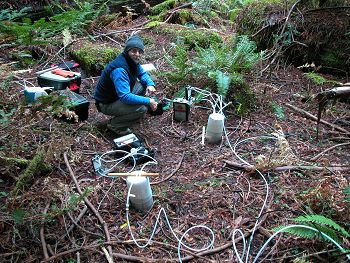Critical Zone Profile - TODD DAWSON (environmental scientist, professor)
Professor Todd Dawson has a long-term interest in and has done a considerable amount of research on the interactions of water, vegetation, and climate. A central goal of Dawson’s work is understanding the various roles trees play in hydrological processes in the broadest sense. More specifically, Dawson studies how trees use and move water in and from the subsurface into the atmosphere in a diversity of landscape types and climatic regions. Dawson is a member of the Eel River Critical Zone Observatory (CZO).
Dawson is climbing a coastal redwood tree in Montgomery Woods State Park in central California, in order to access the weather station at the top of the tree. Photo credit: Kip Evans, National Geographic Photographer.
“Critical zone research couples Earth to biota to atmosphere. It is in and through this zone that the major determinants of Earth system processes occur.” – Todd Dawson
My specific focus is on the ecological physiology of trees. I study both below-ground (root system) functions and leaf and crown responses to key climate drivers like water availability and extreme climate events. I also analyze land-use and climate change impacts on different species of trees and on entire forest ecosystem functions. Water is a central and critical resource that my team keeps careful track of. As we seek to scale up plant-based measurements to whole ecosystems and watersheds, the application of models and interfacing with remote sensing information have become increasingly important in our work.
Recently, several lines of evidence have shown us that trees can play a major role in returning water from the land surface back to the atmosphere. This finding gives us a greater appreciation of the critical role vegetation plays in local, regional, and even global hydrological processes. What is far less clear is how landscape features combine to influence the speed and magnitude of water movement through the “biota” on Earth. Some of the relevant landscape features we look at include: topography, soil and bedrock properties, land-use history and impacts, and climate drivers and climate change. Deepening our understanding of these complex interactions enhances our basic scientific knowledge, and it helps us identify appropriate policies and management strategies.
With a network of CZO sites making many of the same types of observations and measurements, we are in a much better position to see what the similarities and differences among different sites are, and why these may or may not exist.
Dawson is trapping the water vapor being collected from several different heights in a Giant Sequoia forest to determine the relative contribution of evaporation and tree transpiration to the total vapor leaving that forest. His team now does this research using new optically-based isotope measurement systems that collect vapor continuously and in real time. Photo credit: Anthony Ambrose.
If we can identify the key drivers of cross-CZO processes, we may be better positioned to adopt broadly applicable natural resource management plans, policies, and actions. CZO research can help us identify general rules and principles that can be applied in many different locations. Critical zone research should, therefore, be a national priority for enhancing understanding and designing sound natural resource management policies and practices.
I believe it is important to promote critical zone science and awareness in the community. To accomplish this, I give talks at national and international meetings, contribute to peer-reviewed and popular publications, develop web-based resources, and host on-site visits from neighbors, schools, and interested members of the public. I even dressed-up as a CZO for Halloween, which was a real hit with my local community ![]() .
.
:: By Linda Copman, staff writer ::
Dawson is climbing a coastal redwood tree in Montgomery Woods State Park in central California, in order to access the weather station at the top of the tree. Photo credit: Kip Evans, National Geographic Photographer.
Dawson is trapping the water vapor being collected from several different heights in a Giant Sequoia forest to determine the relative contribution of evaporation and tree transpiration to the total vapor leaving that forest. His team now does this research using new optically-based isotope measurement systems that collect vapor continuously and in real time. Photo credit: Anthony Ambrose.
Related News
Explore Further







